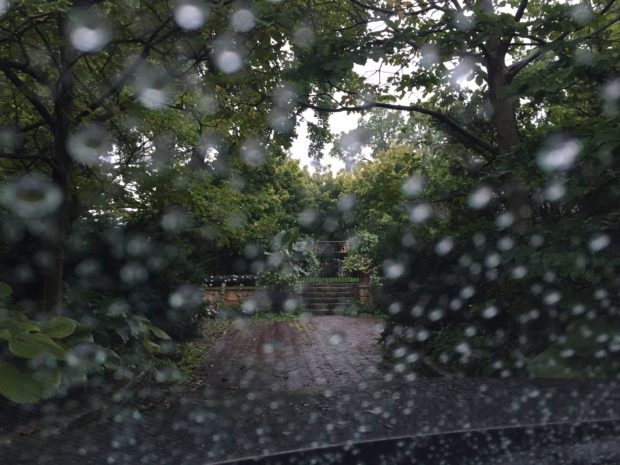 By mid September, change is in the air. As much as I would wish that the summer would persist past Labor Day, it never does. The summer season falters right on cue. The blazing heat generated by the summer sun is waning. The sun is lower in the sky. The garden is cooler. The night temperatures are a little chilly. We are beginning to get a little rain. The plants in my containers are beginning to look like summer is coming to a close. The petunias which have been sulking all summer are sliding headlong into decline. Any thin leaved foliage looks pale and unhappy. The bloom on any container plant is more sparse. The showy oregano blooms in the driveway pots have matured and turned brown. I am lucky for the licorice and nicotiana that has come on strong with the cooler weather. The big thick leaves of the alocasia have not gotten the message yet. They still look great. It is just about time to think about letting go.
By mid September, change is in the air. As much as I would wish that the summer would persist past Labor Day, it never does. The summer season falters right on cue. The blazing heat generated by the summer sun is waning. The sun is lower in the sky. The garden is cooler. The night temperatures are a little chilly. We are beginning to get a little rain. The plants in my containers are beginning to look like summer is coming to a close. The petunias which have been sulking all summer are sliding headlong into decline. Any thin leaved foliage looks pale and unhappy. The bloom on any container plant is more sparse. The showy oregano blooms in the driveway pots have matured and turned brown. I am lucky for the licorice and nicotiana that has come on strong with the cooler weather. The big thick leaves of the alocasia have not gotten the message yet. They still look great. It is just about time to think about letting go.
 The upkeep of my containers is a summer long pursuit. The watering required by our very hot and dry summer was just about a full time job. The driveway garden took a long time to water, as there are plants in ground there too. Once the plants became root bound, their need for water was insatiable. I watered. And watered again. Ordinarily, looking after the pots is generally a pleasure. The maintenance is relaxing. A plant that is unfairly crowding another may need some pruning back. Some flowers need dead heading in order to keep blooming well. Old leaves mature, and need to be removed. Other plants need to be headed back to promote better flowering. Or staked. Most of this is fiddling, and not really work. But once the season begins to turn towards fall, I quit most everything except the watering. My last act was to cut all the flower stalks off the nicotiana mutabilis. They had mostly gone to seed. And I knew they would come on again once the weather cooled off. I favored more flowers over seed. Why do I quit fiddling? What I do to manage the plants is about what I think they need. What plants do when left to their own devices is always an education. Plants grow at different rates. Some tolerate crowding while others do not. Some grow much bigger than expected. Others languish. How every plant in a container adjusts to a lack of intervention from me is interesting to watch.
The upkeep of my containers is a summer long pursuit. The watering required by our very hot and dry summer was just about a full time job. The driveway garden took a long time to water, as there are plants in ground there too. Once the plants became root bound, their need for water was insatiable. I watered. And watered again. Ordinarily, looking after the pots is generally a pleasure. The maintenance is relaxing. A plant that is unfairly crowding another may need some pruning back. Some flowers need dead heading in order to keep blooming well. Old leaves mature, and need to be removed. Other plants need to be headed back to promote better flowering. Or staked. Most of this is fiddling, and not really work. But once the season begins to turn towards fall, I quit most everything except the watering. My last act was to cut all the flower stalks off the nicotiana mutabilis. They had mostly gone to seed. And I knew they would come on again once the weather cooled off. I favored more flowers over seed. Why do I quit fiddling? What I do to manage the plants is about what I think they need. What plants do when left to their own devices is always an education. Plants grow at different rates. Some tolerate crowding while others do not. Some grow much bigger than expected. Others languish. How every plant in a container adjusts to a lack of intervention from me is interesting to watch.
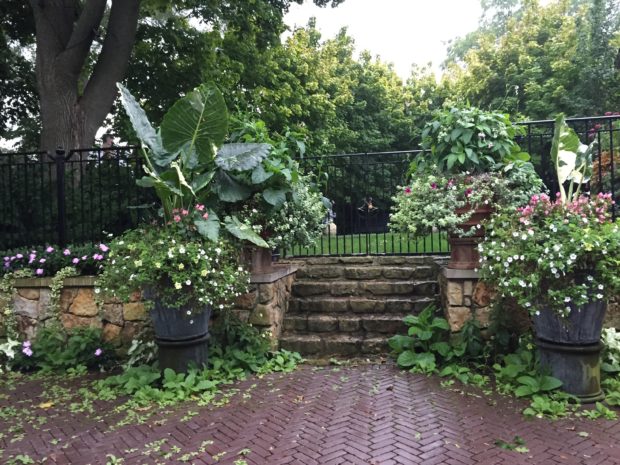 For whatever reason, nicotiana seedlings by the thousands appeared in the driveway in June. I have never seen this happen, not in 20 years. I have no explanation for this, beyond the fact that the nicotiana mutabilis started going to seed early – I suspect from the heat. And I was watering a lot. But these seedlings did not necessarily look to be mutabilis to me. Pulling them out of the bricks would have been no small amount of work. In spite of my propensity for order, it seemed like a better plan to just be grateful that I had all those volunteers working this garden. Any plant that wished to grow in the driveway this summer was welcome to do so. Of course the most robust group of seedlings were those in proximity to the water draining out of the pots.
For whatever reason, nicotiana seedlings by the thousands appeared in the driveway in June. I have never seen this happen, not in 20 years. I have no explanation for this, beyond the fact that the nicotiana mutabilis started going to seed early – I suspect from the heat. And I was watering a lot. But these seedlings did not necessarily look to be mutabilis to me. Pulling them out of the bricks would have been no small amount of work. In spite of my propensity for order, it seemed like a better plan to just be grateful that I had all those volunteers working this garden. Any plant that wished to grow in the driveway this summer was welcome to do so. Of course the most robust group of seedlings were those in proximity to the water draining out of the pots.
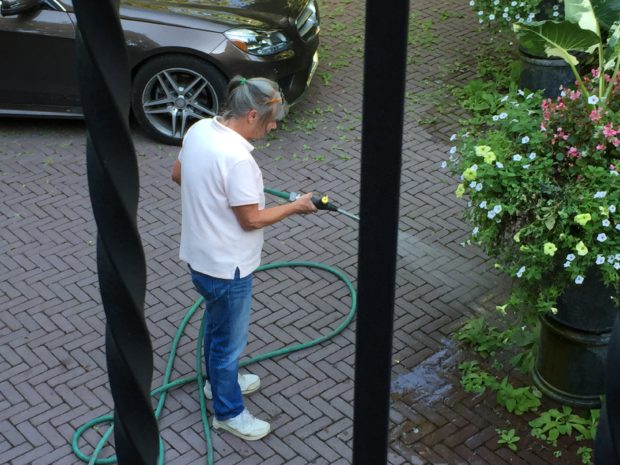 I eventually took to watering them on purpose. Buck would sit on the deck so we could talk while I was watering in the drive. He had a lot of questions about why there were so many weeds in the drive, and my reason for watering them, but I waved him off. If I had set out to grow nicotiana in the brick, I am sure my efforts would have been an utter failure. No doubt nature was in charge of this event. For some reason, conditions were perfect for nicotiana seed to germinate.
I eventually took to watering them on purpose. Buck would sit on the deck so we could talk while I was watering in the drive. He had a lot of questions about why there were so many weeds in the drive, and my reason for watering them, but I waved him off. If I had set out to grow nicotiana in the brick, I am sure my efforts would have been an utter failure. No doubt nature was in charge of this event. For some reason, conditions were perfect for nicotiana seed to germinate.
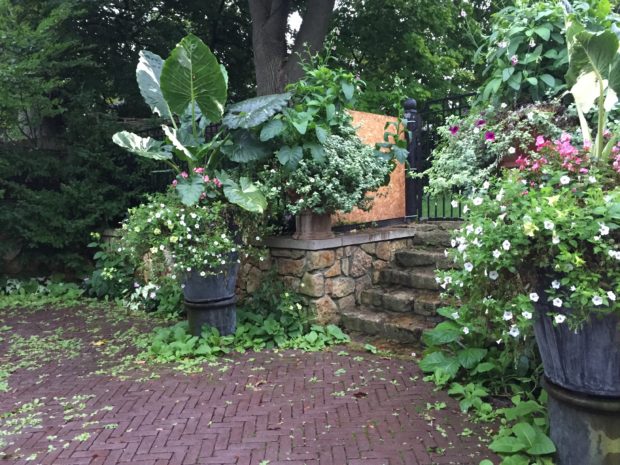 The very first seedling to bloom was nicotiana alata lime – a cultivar which I am growing in the ground this year. I never got a chance to take a picture of it, as I accidentally ripped the plant out of the brick dragging the hose over it. Dang it all. If you are a gardener, you know that any plant you kill is a burden to be born by you alone. Anyone else would yawn.
The very first seedling to bloom was nicotiana alata lime – a cultivar which I am growing in the ground this year. I never got a chance to take a picture of it, as I accidentally ripped the plant out of the brick dragging the hose over it. Dang it all. If you are a gardener, you know that any plant you kill is a burden to be born by you alone. Anyone else would yawn.
The next to bloom was nicotiana langsdorfii, which I have not grown in these pots for at least 8 years. It could be my letting go in September many years ago resulted in seed that has laid dormant in between the bricks for years, only to be induced to sprout for some unknown reason this June. I suppose it could be that the frequency of my watering kept the sand between the bricks moist long enough for the seed to sprout. Nicotiana langsdorfii, from whence did you come?
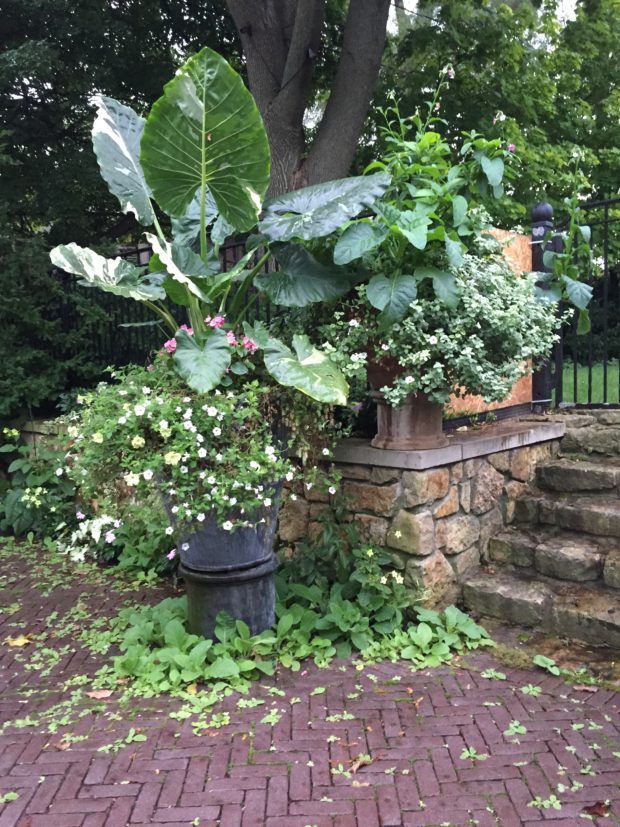 Up close it is easier to see how the letting go is creating a new dynamic. There was no reason to remove the variegated alocasia leaf that was shading the showy oregano. That oregano had already given up. The green leaf hovering over the dead oregano was a much better look. The large lower leaves of nicotiana mutabilis in the upper pot covered the bare stems of the licorice close to the soil line. I have never had any trouble growing licorice, but this year all of the leaves on the stems close to the soil died back. I have no idea why. The licorice recovered, and had grown vigorously all through and on top of the puny petunias. These pots, left to their own devices, are looking better than they did 2 weeks ago. The alocasia is very happy, on the house side. The back side of this pot is in a fairly shady spot. The sunny side is the primary viewing side. Driving up the drive, the alocasia is leaning towards the light. One of the most difficult parts of container planting design is picking the plants that will be able to handle and perform in light conditions that vary.
Up close it is easier to see how the letting go is creating a new dynamic. There was no reason to remove the variegated alocasia leaf that was shading the showy oregano. That oregano had already given up. The green leaf hovering over the dead oregano was a much better look. The large lower leaves of nicotiana mutabilis in the upper pot covered the bare stems of the licorice close to the soil line. I have never had any trouble growing licorice, but this year all of the leaves on the stems close to the soil died back. I have no idea why. The licorice recovered, and had grown vigorously all through and on top of the puny petunias. These pots, left to their own devices, are looking better than they did 2 weeks ago. The alocasia is very happy, on the house side. The back side of this pot is in a fairly shady spot. The sunny side is the primary viewing side. Driving up the drive, the alocasia is leaning towards the light. One of the most difficult parts of container planting design is picking the plants that will be able to handle and perform in light conditions that vary.
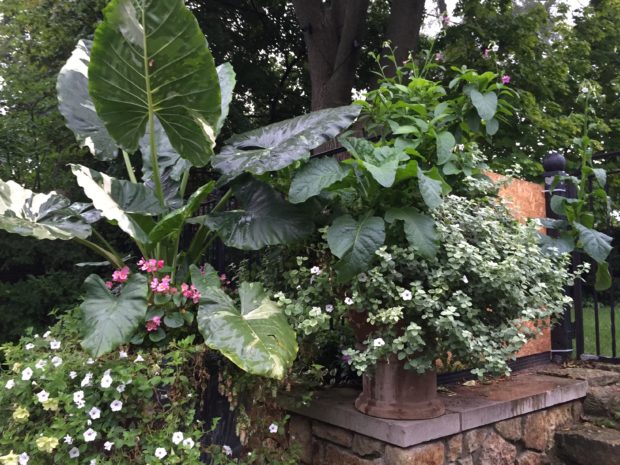 Buck has enjoyed the alocasia all summer. He kept me posted if a leaf was turning brown, or developed a hole or tear. I have never grown them before, so I am giving them a serious look. They are slow to get started. Given plenty of heat, they thrive. They react very slowly to change. It’s clear they can anchor a summer container on in to the fall.
Buck has enjoyed the alocasia all summer. He kept me posted if a leaf was turning brown, or developed a hole or tear. I have never grown them before, so I am giving them a serious look. They are slow to get started. Given plenty of heat, they thrive. They react very slowly to change. It’s clear they can anchor a summer container on in to the fall.
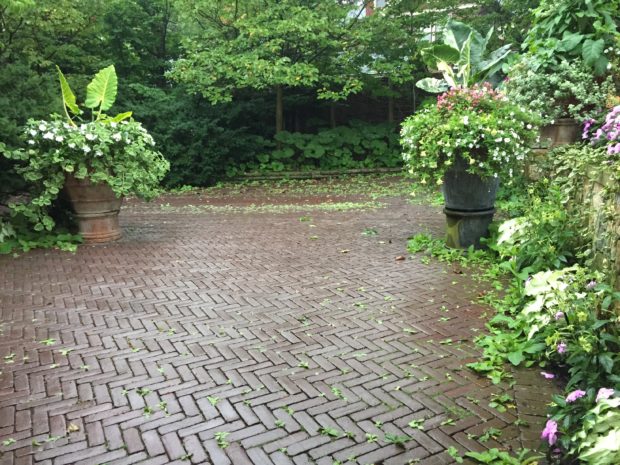 I have learned that my driveway is not just a place to park.
I have learned that my driveway is not just a place to park.
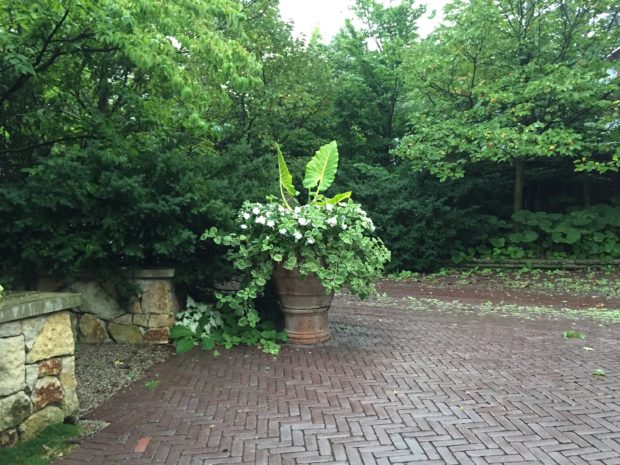 Welcome to the September nicotiana fest underway in the driveway.
Welcome to the September nicotiana fest underway in the driveway.
